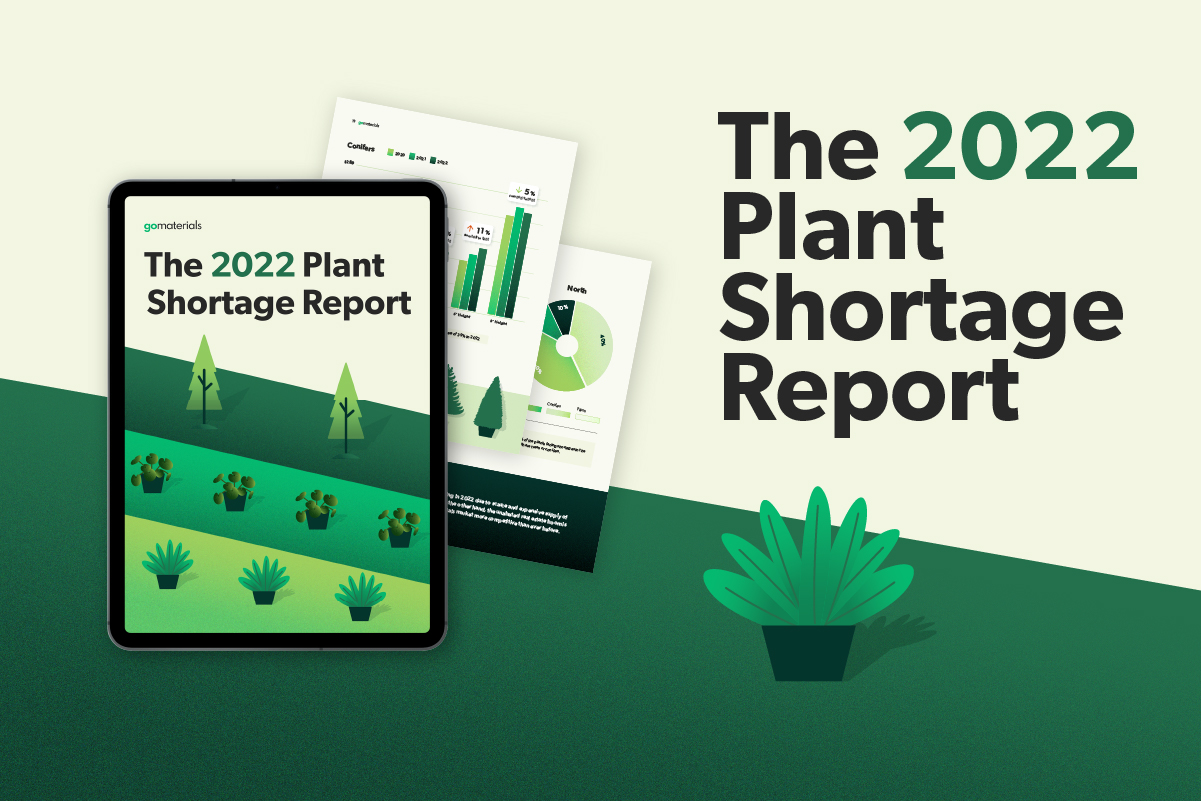Three Crucial Landscaping Industry Data Insights from the 2022 Plant Shortage Report

In 2021, the landscaping industry went through an unprecedented plant shortage crisis. Multiple factors such as the Texas freeze, coupled with the plastic resin shortage contributed to many popular plants and trees going out of stock. A year later, it’s important to check where we are as an industry when it comes to plant shortages. The short answer is – there’s a long way to go for a full recovery. The data from the 2022 Plant Shortage Report might help landscaping industry players in making the necessary process adjustments to adapt for the year to come.
Here are three crucial landscaping industry data points from GoMaterials‘ report.
63% of the Shortages in the Southeast USA are in the Shrubs, Perennials, or Ornamental Grasses Category
The landscaping industry data from the report reveals specific categories facing a more severe shortage, pointing towards larger trends. For example, water-wise landscaping is rising across multiple US states, and bylaws or mandates issued for ‘hardy’ plants and shrubs are increasing the demand for such materials. Shrubs in particular lead the shortages as the single largest category at 25%, followed by perennials and ornamental grasses at 19% respectively.
Another important trend is the longer recovery period for plants. The practice of using smaller-sized plant material as a replacement for the larger spec requirements seems to have extended the recovery period. Only two plants mentioned in the 2021 edition of the report (Pink Muhly and Foxtail Fern) have seen a partial recovery in 2022.
80% of the Shortages in the Northeast USA are Conifers or Trees
As we move to the North, trees, and conifers are leading the shortages. Both categories combined account for a whopping 80% of the shortages across the Northern regions. The limited availability of tree whips since 2021 due to labor and supply chain constraints seems to be the underlying factor for shortages in the North.
With no tree whips, and longer lead times needed to achieve the expected specs, most wholesale growers may be unable to fulfill the demand for a long time. Especially for conifers and trees with a slower growth rate. The Ginkgos, for example, are now in a ‘chronic’ state of shortage, with a long road ahead for recovery. Their slower growth rate makes them untenable as an investment for some wholesalers. On the other hand, the ability of Ginkgos to withstand the urban environment makes them ideal for city planners. Ostrya Virginiana and Maackia Amurensis are also excellent examples of the same pattern of slow growth and high demand causing a shortage.
16% Price Hike on Average Across All Categories and Sizes
When it comes to the pricing, interpreting the landscaping industry data can get more difficult. The pricing can change based on seasons, sub-regions, quality, specs, etc., making a universal benchmark harder. Having said that, the larger pricing trends covered in the 2022 Plant Shortage report can still be used as an indicator of where the prices are headed.
To start with, all materials across the most common categories are selling at an average 16% higher than their 2021 prices. Although the hike percentage varies to a great extent for specific sizes under each category. For instance, one-gallon shrubs in the southeast USA have the highest price hike across all plant categories at 40%, while 15 Gallon sizes are reporting just a 5% increase.
Additionally, the pricing trends also diverge based on the material categories. Trees and conifers in the Northeast USA for example have slightly different price hike patterns. While 2”-4” caliper trees have increased between 11% to 47%, price hikes aren’t as consistent across sizes for conifers. In fact, the prices for some sizes such as the 3 Gallon pot-grown conifers have dropped by 42%. It must be noted however that even sizes that are reporting a decrease in average price are yet to reach their pre-2020 levels.
Finally, pricing trends often serve as the basis to decide the severity of the shortage. It’s no coincidence that plants that are in partial recovery such as the Pink Muhly grass have seen a slight decline in their average prices.
Bonus Landscaping Industry Data Insight About Sizes
A key observation from two consecutive shortage reports is the fact that shortages are moving from larger to smaller sizes. While 3 Gallon pot sizes (with the expected specs) are the hardest to source based on the 2022 Plant Shortage report, a closer look at specific species can tell a story. Take Myrica Cerifera or Wax Myrtle for example. In the 2021 edition of the report, only the 15 Gallon or larger sizes were harder to find for this plant. In comparison, even three- and seven-gallon sizes are in short supply for the Wax Myrtle in 2022. A probable reason for this trend can be short-term replacement tactics deployed last year that attempted to fill the gap using smaller specs, thereby affecting the future inventory.
Since plant materials can account for up to 30% of the total costs borne by landscaping businesses, any fluctuations in their pricing or availability can send shockwaves through the industry. Chronic plant shortages in 2022 are a culmination of changing market dynamics, and the slower pace of the industry to catch up. What’s more, with a higher inflation rate, and uncertainty about growth prospects may again change some of the current materials and labor cost estimates as the year progresses. However, learning where we stand today as an industry in terms of availability and pricing will be crucial for successful landscaping businesses.
***
Continue exploring plant availability and pricing trends in depth by downloading your free copy of the 2022 Plant Shortage Report! Already read the report? Tell us what you’d like to know next on social media!

